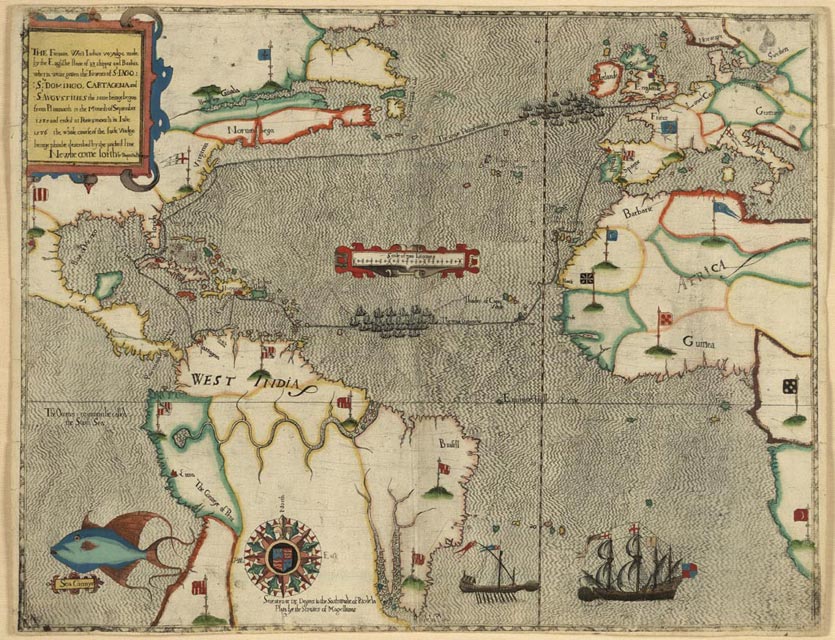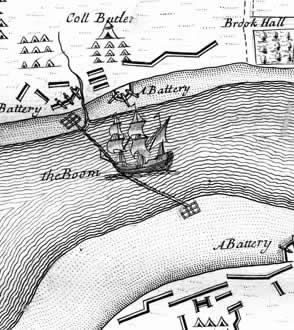|
Battle Of Cartagena De Indias (1586)
The Battle of Cartagena de Indias (1586) or the Capture of Cartagena de Indias was a military and naval action fought on 9–11 February 1586, of the recently declared Anglo-Spanish War that resulted in the assault and capture by English soldiers and sailors of the Spanish colony city of Cartagena de Indias (now part of Colombia) governed by Pedro de Bustos on the Spanish Main. The English were led by Francis Drake. The raid was part of his ''Great Expedition'' to the Spanish New World. The English soldiers then occupied the city for over two months and captured much booty along with a ransom before departing on 12 April. Origins War had already been unofficially declared by Philip II of Spain after the Treaty of Nonsuch in which Elizabeth I had offered her support to the rebellious Protestant Dutch rebels. The Queen through Francis Walsingham ordered Sir Francis Drake to lead an expedition to attack the Spanish New World in a kind of preemptive strike. Sailing from Plymouth ... [...More Info...] [...Related Items...] OR: [Wikipedia] [Google] [Baidu] |
Anglo-Spanish War (1585–1604)
The Anglo-Spanish War (1585–1604) was an intermittent conflict between the Habsburg Kingdom of Spain and the Kingdom of England. It was never formally declared. The war included much English privateering against Spanish ships, and several widely separated battles. It began with England's military expedition in 1585 to what was then the Spanish Netherlands under the command of the Earl of Leicester, in support of the Dutch rebellion against Spanish Habsburg rule. The English enjoyed a victory at Cádiz in 1587, and repelled the Spanish Armada in 1588, but then suffered heavy setbacks: the English Armada (1589), the Drake–Hawkins expedition (1595), and the Essex–Raleigh expedition (1597). Three further Spanish armadas were sent against England and Ireland in 1596, 1597, and 1601, but these likewise ended in failure for Spain, mainly because of adverse weather. The war became deadlocked around the turn of the 17th century during campaigns in the Netherlands, France, a ... [...More Info...] [...Related Items...] OR: [Wikipedia] [Google] [Baidu] |
Dutch Revolt
The Eighty Years' War or Dutch Revolt ( nl, Nederlandse Opstand) (Historiography of the Eighty Years' War#Name and periodisation, c.1566/1568–1648) was an armed conflict in the Habsburg Netherlands between disparate groups of rebels and the Spanish Empire, Spanish government. The Origins of the Eighty Years' War, causes of the war included the Reformation, centralisation, taxation, and the rights and privileges of the nobility and cities. After Eighty Years' War, 1566–1572, the initial stages, Philip II of Spain, the sovereign of the Netherlands, deployed Army of Flanders, his armies and Eighty Years' War, 1572–1576, regained control over most of the rebel-held territories. However, Spanish Fury, widespread mutinies in the Spanish army caused a general uprising. Under the leadership of the exiled William the Silent, the Catholic- and Protestant-dominated provinces sought to establish religious peace while jointly opposing the king's regime with the Pacification of Ghent ... [...More Info...] [...Related Items...] OR: [Wikipedia] [Google] [Baidu] |
Sir Francis Drake (post 1580)
Sir Francis Drake ( – 28 January 1596) was an English explorer, sea captain, privateer, slave trader, naval officer, and politician. Drake is best known for his circumnavigation of the world in a single expedition, from 1577 to 1580 (the first English circumnavigation, the second carried out in a single expedition, and third circumnavigation overall). This included his incursion into the Pacific Ocean, until then an area of exclusive Spanish interest, and his claim to New Albion for England, an area in what is now the U.S. state of California. His expedition inaugurated an era of conflict with the Spanish on the western coast of the Americas, an area that had previously been largely unexplored by Western shipping. He was Member of Parliament (MP) for three constituencies; Camelford in 1581, Bossiney in 1584, and Plymouth in 1593. Elizabeth I awarded Drake a knighthood in 1581 which he received on the ''Golden Hind'' in Deptford. In the same year, he was appointed mayor ... [...More Info...] [...Related Items...] OR: [Wikipedia] [Google] [Baidu] |
64 - Carthagène - Décembre 2008
64 or sixty-four or ''variation'', may refer to: * 64 (number) Dates * one of the years 64 BC, AD 64, 1864, 1964, 2064, etc. * June 4th (6/4) ** the date of the 1989 Tiananmen Square protests and massacre * April 6th (6/4) * April 6 AD (6/4) * June 4 AD (6/4) Places * Highway 64, see list of highways numbered 64 ** Interstate 64, a national route in the United States * +64, country code dialing code of New Zealand; see Telephone numbers in New Zealand * 64 Angelina (asteroid 64), a main-belt asteroid Other uses * Nintendo 64, the third home console by Nintendo, released in 1996 * Commodore 64 * 64-bit computing * "64" (song), a 2011 song by hip hop band Odd Future * ''Sixty Four'' (album), a 2004 album recorded in 1964 by Donovan * Sixty-four (ship), a type of sailing warship * A /64 Classless Inter-Domain Routing Classless Inter-Domain Routing (CIDR ) is a method for allocating IP addresses and for IP routing. The Internet Engineering Task Force introduced CIDR in 1993 to ... [...More Info...] [...Related Items...] OR: [Wikipedia] [Google] [Baidu] |
Officer Of Pikemen
An officer is a person who has a position of authority in a hierarchical organization. The term derives from Old French ''oficier'' "officer, official" (early 14c., Modern French ''officier''), from Medieval Latin ''officiarius'' "an officer," from Latin ''officium'' "a service, a duty" the late Latin from ''officiarius'', meaning "official." Examples Ceremonial and other contexts *Officer, and/or Grand Officer, are both a grade, class, or rank of within certain chivalric orders and orders of merit, e.g. Legion of Honour (France), Order of the Holy Sepulchre (Holy See), Order of the British Empire ( UK), Order of Leopold (Belgium) *Great Officer of State *Merchant marine officer or licensed mariner *Officer of arms *Officer in The Salvation Army, and other state decorations Corporations *Bank officer *Corporate officer, a corporate title **Chief executive officer (CEO) **Chief financial officer (CFO) **Chief operating officer (COO) *Executive officer Education *Chief academic of ... [...More Info...] [...Related Items...] OR: [Wikipedia] [Google] [Baidu] |
Boom (navigational Barrier)
A boom or a chain (also boom defence, harbour chain, river chain, chain boom, boom chain or variants) is an obstacle strung across a navigable stretch of water to control or block navigation. In modern times they usually have civil uses, such as to prevent access to a dangerous river channel. But, especially historically, they have been used militarily, with the goal of denying access to an enemy's ships: a modern example is the anti-submarine net. Booms have also been used to force passing vessels to pay a toll. Description A boom generally floats on the surface, while a chain can be on the surface or below the water. A chain could be made to float with rafts, logs, ships or other wood, making the chain a boom as well. Historical uses Especially in medieval times, the end of a chain could be attached to a chain tower or boom tower. This allowed safe raising or lowering of the chain, as they were often heavily fortified. By raising or lowering a chain or boom, access could be s ... [...More Info...] [...Related Items...] OR: [Wikipedia] [Google] [Baidu] |
Martin Frobisher
Sir Martin Frobisher (; c. 1535 – 22 November 1594) was an English seaman and privateer who made three voyages to the New World looking for the North-west Passage. He probably sighted Resolution Island near Labrador in north-eastern Canada, before entering Frobisher Bay and landing on present-day Baffin Island. On his second voyage, Frobisher found what he thought was gold ore and carried 200 tons of it home on three ships, where initial assaying determined it to be worth a profit of £5.20 per ton. Encouraged, Frobisher returned to Canada with an even larger fleet and dug several mines around Frobisher Bay. He carried 1,350 tons of the ore back to England, where, after years of smelting, it was realized that the ore was a worthless rock containing the mineral hornblende. As an English privateer, he plundered riches from French ships. He was later knighted for his service in repelling the Spanish Armada in 1588. Early life Martin Frobisher was probably born in 1535 or 1536, ... [...More Info...] [...Related Items...] OR: [Wikipedia] [Google] [Baidu] |
English Ship Bonaventure (1567)
''Bonaventure'' (also known as ''Elizabeth Bonaventure'') was a 47-gun galleon purchased by the Royal Navy in 1567. She was the third vessel to bear the name. She was commanded by Sir Francis Drake during his 1587 attack on Cadiz, and a year later was part of the fleet to face the Spanish Armada. Service history The ship took part in the Great Expedition by privateer Francis Drake, which raided the Spanish New World in 1585 and 1586. As part of the Expedition, ''Bonaventure'' was present for Drake's assaults on Santo Domingo, Cartagena de Indias and San Augustin. Attack on Cadiz (1587) After the execution in February 1587 of Mary, Queen of Scots, Philip II of Spain decided that it was time to invade England, and started to prepare his armada.Elton (1906), p81. ''Bonaventure'', under the command of Francis Drake was sent as flagship of the English fleet to try to prevent and/or delay the armada. The fleet numbered roughly twenty-six vessels, which included three more of ... [...More Info...] [...Related Items...] OR: [Wikipedia] [Google] [Baidu] |


.jpg)


.jpg)